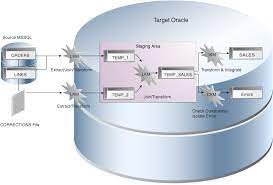A multinational retail company operates in multiple countries and wants to integrate sales data from various sources into a centralized data warehouse for analysis and reporting purposes. The company receives sales data from different store systems, online platforms, and third-party vendors. They need to consolidate and transform the data into a consistent format to gain insights into sales performance, customer behavior, and inventory management.
ODI Concepts and Skills Applied:
- Data Model Design:
- Analyze the source systems and define a comprehensive data model for the centralized data warehouse.
- Identify the relevant entities, attributes, and relationships required to capture sales data accurately.
- Design dimension tables for products, customers, stores, and time to enable multidimensional analysis.
- ODI Projects and Interfaces:
- Create an ODI project to manage the development and deployment of the data integration solution.
- Develop ODI interfaces to extract, transform, and load sales data from various source systems into the data warehouse.
- Use ODI mappings to define the transformations required to standardize and cleanse the incoming data.
- Knowledge Modules (KMs):
- Utilize appropriate KMs for different integration scenarios.
- Choose the appropriate Integration Knowledge Modules (IKMs) and Loading Knowledge Modules (LKMs) to optimize the data loading process.
- Customize KMs if necessary to handle specific requirements, such as complex transformations or data validation rules.
- Error Handling and Logging:
- Implement error handling mechanisms in ODI interfaces to capture and handle data integration errors.
- Configure error tables to store error records for later analysis and reconciliation.
- Use ODI’s logging capabilities to monitor and track the execution of interfaces, capturing relevant statistics and debugging information.
- Data Quality and Cleansing:
- Apply data quality techniques to cleanse and standardize the incoming sales data.
- Implement data validation rules and checks to ensure the accuracy and integrity of the integrated data.
- Use ODI’s data quality features, such as data profiling and data cleansing transformations, to improve data quality.
- Scheduling and Automation:
- Schedule the execution of ODI interfaces to run at regular intervals to keep the data warehouse up to date.
- Utilize ODI’s scheduling capabilities to automate the data integration process, minimizing manual intervention.
- Set up dependencies and sequencing within ODI Load Plans to ensure the proper order of execution and data consistency.
- Performance Optimization:
- Optimize the performance of ODI interfaces and mappings.
- Leverage ODI’s parallel execution features to process data in parallel, improving throughput.
- Optimize SQL queries, use appropriate indexes, and leverage database-specific features to enhance performance.
- Documentation and Metadata Management:
- Maintain comprehensive documentation of the data integration solution.
- Document the data model, mappings, transformations, and business rules implemented in ODI.
- Use ODI’s metadata management capabilities to capture and manage metadata about the source systems, data transformations, and data lineage.
- Testing and Validation:
- Perform thorough testing and validation of the data integration solution.
- Develop test cases and use representative data sets to validate data extraction, transformation, and loading processes.
- Verify data accuracy, completeness, and consistency in the data warehouse.
- Monitoring and Maintenance:
- Set up monitoring and alerting mechanisms to track the execution status of ODI interfaces and detect any issues or failures.
- Establish a maintenance plan to handle changes in the source systems, data model updates, or evolving business requirements.
- Regularly monitor performance, resolve any data integration errors, and optimize the solution based on feedback and usage patterns.
By applying these ODI concepts and skills to the sales data integration case study, you can create an efficient, scalable, and robust data integration solution that provides valuable insights for the retail company’s sales operations.
SHARE
